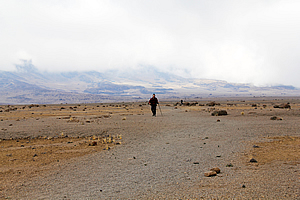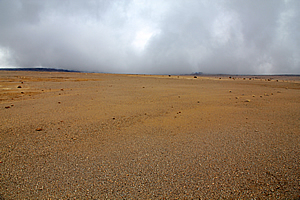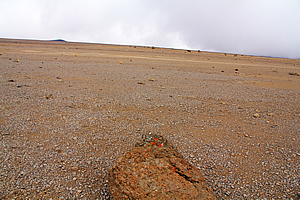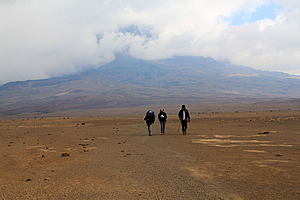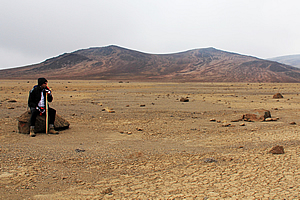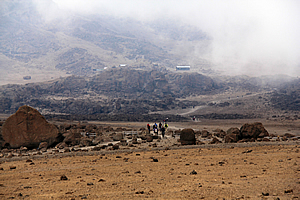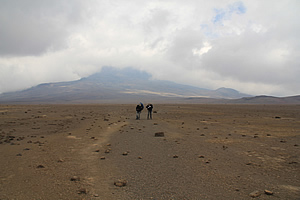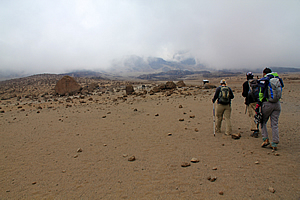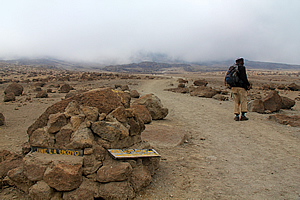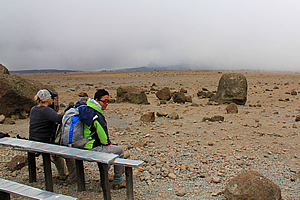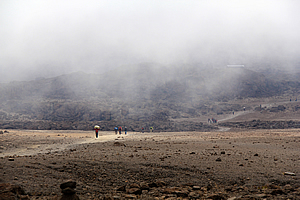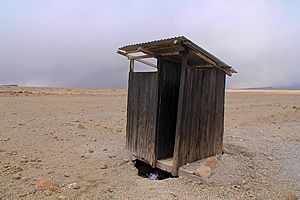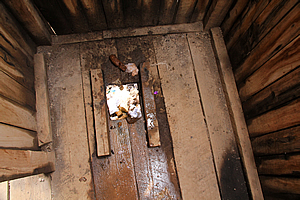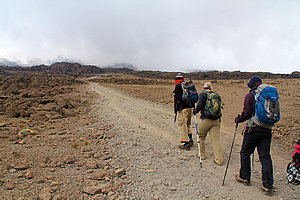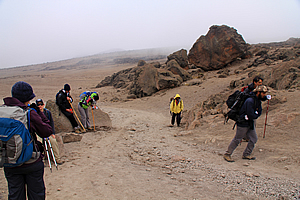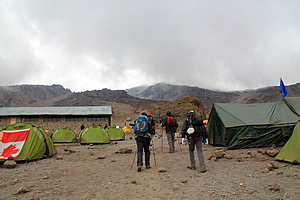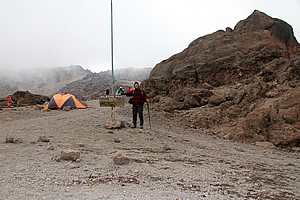--- Archive files ---
Home > Treks > Kilimanjaro > Day 5 > 5.3 |
Finding Yourself on the Mountains of Insanity
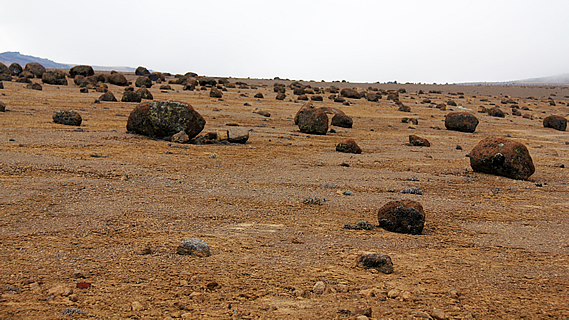
AT THE rest stop I gave my camera to Vicky, and she took a few shots of me walking off into the distance and coming back. I figured if I ever needed any photos of me in a very lonely and remote location, this would be it. When I returned, it was time for us to move on again. I thanked her for taking my picture and we talked as we staggered our way across the Martian landscape.
Me walking across the barren desert |
The cloud was quickly rising along the edge of the saddle about a kilometre away. Part of the cloud mass was obviously rain-bearing – or perhaps snow-bearing. It was very cold here. Snow would have been nice. Rain on the other hand would have been miserable in these frigid conditions.
I asked Vicky why she was up here on Kilimanjaro, especially as she has not done much hiking at all in the past. She was just here as part of a longer tour that had started off in the Serengeti. She didn’t have any real reason to do this but decided it was definitely going to be a once in a lifetime experience. She told me that her sister had thought she was doing this journey up the mountain to find herself. After all many people go off to far flung places and put themselves through the torture of hiking in inhospitable places as a way for them to find themselves.
Lifeless desert |
I really liked that idea. I mentioned to her that I go on these hikes quite often, and as I do so, I find out a bit about myself. Several weeks ago I had a friend who would tell me that a lot of people go off and do weekend courses paying thousands of dollars to a motivational speaker in the hope they would find themselves. That sounded boring to me. If I wanted to spend thousands of dollars to go and find myself I would much rather do so in a ridiculously exotic location such as this – exactly as I was doing now. As much as I do love attending weekend seminars, going on an adventure like this is far more effective than any formal program.
Boulder on regolith |
I told Vicky the reason why I was up here. As a child I was the least fit of my peers. Looking back then I would have been the last person to have ended up being the fit adventurer. Funny how I was the runt of the litter back then, but in recent years with the emergence of social networking technology, I had been surprised to have seen that the really fit and popular classmates who I would have thought would have be very athletic throughout their adulthoods looked surprisingly old and out of shape. I think I’m the only one from my school who has done these treks even though I should have perhaps been the one who ended up in a wheelchair.
Hiking across the desert |
I suppose as a way to prove myself, and to find myself, I was on track to observe the celebration of my fortieth birthday by reaching the summit, which was now unseen. Most mountains I have climbed over the years have had one thing in common. The summit was never clearly visible until near the very top. Sometimes I would think I would see the summit only to become disappointed upon approaching the top to see there was more to go. On one or two mountains I have climbed, this has occurred not once, but several times. Each time I could have easily given up and turned back, but with my failure is not an option approach to this I’d always pressed on to reach the summit. In fact to date I have never turned back having fallen short of a summit attempt. Pressing on when every muscle in your body is screaming to turn back builds character.
Hiker resting on the desert |
That being said though, this was my first seriously high climb into dangerously high altitudes. I was already higher than I had ever been before and only five or six hundred metres below the danger zone at five thousand metres. Every step of this journey was a bit of a step of faith for me. The weather conditions here on the plateau were very tough now causing my lips to crack. I was now beginning to doubt my ability to reach the summit in about seventeen hours’ time, especially with a long overnight climb tonight. I was thankful though my legs were no longer as sore as they had been over the past two days. The sudden exertion from climbing to the waterfall at Marangu was over. That was now a full three vertical kilometres below me in much warmer climes.
The cloud clears revealing Kibo Hut still a long way away |
The slope of the plateau was starting to grade upwards in anticipation of the now enshrouded Kibo Peak, giving a disorienting illusion that the world was tilted up. Well this part of the world definitely was a bit tilted. The assortment of boulders that had been strewn over the regolith in the early part of the plateau had gone now and the flat regolith was just shingle rubble with absolutely no vegetation. This really was alpine desert here – how could anything survive up here?
Lifeless desert |
At times it would appear Kibo Peak was getting closer but most of the time it actually seemed to be shrinking away. The gradual slope towards it was gradually steepening making it even more difficult in the increasingly thinning air. It was very cold and we were all rugged up, but fortunately it hadn’t started raining or snowing. The area over Mawenzi Peak and the pass we had crossed earlier was all fogged over and appearing to rain now. We were struggling along now at over four thousand five hundred metres above sea level.
It was deathly silent and very lonely here. The only sign of life was my fellow hikers staggering along against the inhospitable conditions of this barren alpine desert.
Getting close to the main trail |
Suddenly the cloud blocking our view of Kibo Peak lifted in front of us just enough to see Kibo Hut. It definitely was a lot closer now, but still little more than a couple of dots ahead of us. Now I realised there is going to be quite a climb, with at least a hundred metres of vertical rise up to the hut. That last bit was going to be a killer. A hundred metres climb is nothing at sea level, but at four and a half kilometres above sea level after walking for three days this was going to be a huge spirit-breaking challenge. Beneath the hut, at the start of the climb, I could see a group of people resting. This must be where the upper and lower tracks meet. Most people hike the lower trail, so it wasn’t going to be as lonely any more.
Jiwe La Ukoyo |
After another five agonising minutes, we reached the junction. The two trails met in amongst some huge boulders thrown down from Kibo Peak perhaps hundreds of thousands of years ago during the great eruptions, or carried down by glaciers when permanent ice covered the whole of Kibo Peak for tens of thousands of years up until just around eighty years ago. The main track from Horombo met the smaller one we had been walking on across the plateau. The main track had come from a pass over the edge of the plateau between two very Martian like hills. The track was like wide enough for a four wheel drive vehicle to easily negotiate.
Resting at Jiwe La Ukoyo |
At the junction was a small pile of rocks cemented together with a couple of signs on it. The first sign read Jiwe La Ukoyo – the name of the junction. It means pointed rocks, supposedly at 4394 metres above sea level. Another sign lying on the rock, having obviously become detached from its original mounting, had two arrows. One of the arrows pointed back down the main track saying Horombo Hut 7.8 km. More importantly the other arrow said Kibo Hut 1.46 km. There was another sign across the track saying Mawenzi Hut 6.27 km. The hut is at 4703 metres above sea level.
The trail going up the mountain towards Kibo Hut |
That last one and a half kilometres with a three hundred and nine metre rise in a one in five gradient was going to be tough so we stopped at one of the metal picnic tables for a rest and afternoon tea. The cold aluminium table top was no wider than each bench that we sat on, but it was perfectly functional. Thick mist obscured the climb up to the hut, but I could still see it through the clouds and I could still see the track winding its way backwards and forwards across the face of the slope before disappearing behind some more huge boulders which had no doubt rolled down the mountain in times past perhaps during a violent eruption.
Disgusting toilet |
Having been drinking as much as I possibly could, I needed to use the toilet, and fortunately there were a couple of long drops handy. I was getting very cold very quickly, so I had to get up anyway. I staggered over to the nearest toilet with the aid of my walking pole. The derelict wooden long drop stood over a hole that had expanded beyond the floorboards in front. I was surprised the entire toilet hadn’t fallen in. In the hole I could see a huge pile of faeces and toilet paper coming to within a few centimetres of the bottom of the hut. Although it was almost frozen, the stench was unbelievable, and I tried to hold my breath for as much as I could, but that was impossible to do here in the very thin oxygen-starved alpine air.
Eww... |
I went to use the toilet. There was a faecal stool sitting beside the square hole in the floorboards where you are supposed to aim. People don't aim too well at high altitude so it seems as most of the floor was saturated with urine that didn’t make it in the hole. That all being said, when you gotta go, you gotta go, so I took what will have to go down in history as being the most nauseatingly disgusting piss I have ever taken.
On my way back to the group I saw Dawn who also had an obviously strong urge to go. I told her that I hope you have a strong stomach. She took one look at the toilet and decided to hold on until she got to Kibo.
Looks deceptively flat, but this is a hard moderate climb in freezing and oxygen started conditions |
Quite a lot of porters were passing us carrying gear from Horombo to the Kibo base camp. It had been very quiet walking across the desert as we had been the only group and it had been porter free.
Despite their enormous loads on their heads, the porters were still walking along comfortably oblivious to the polé polé that was being drilled into all the tourists. Perhaps their lungs had enormous capacity like the Incan descendants I had encountered in Peru.
Whilst watching the porters walk by, we sat at the freezing cold aluminium picnic table nibbling on our leftovers from lunch, feeling quite tired, cold and having a bit of a loss of appetite from the altitude.
Very tough going in the final ascent to the huts |
It was very painful getting up. My muscles were almost locked up and certainly didn’t want to move. We set off and started staggering along the track again like old people in a rest home going for a stroll with their walking frames. The slope started off fairly slight, but gradually steepened. Soon we were climbing up the moderately steep section, perhaps just fifteen to twenty degrees, but it felt far steeper at such high altitude.
Jono was still going well despite his fifteen kilogramme pack. Jaseri had apparently told Jono’s porter to just take his pack off him at the first opportunity, but Jono managed to evade the porter as he was determined to take his pack all the way up to Kibo. With a little over a kilometre to go it looked like he was going to be successful. He was stuffed, but I don’t think he was at all regretting having taken it all the way up here. This will certainly be a first.
Arriving at Kibo |
We took one agonising step after another, all keeping together following Jaseri’s lead. The cloud rose before us, so we were never enveloped by it. For a while we completely lost sight of the huts as we passed under the big bluffs. Losing sight of the goal was heart breaking.
Finally the hut appeared again, and now they were a lot closer, along with a number of green tents that had been pitched in the area. One of the green tents had a large Canadian flag draped over it, so this must be a big group from Canada. The orange and grey domed tent I had seen yesterday at Horombo was pitched up here too.
At the huts 4700m above sea level. |
We staggered past the main hut to a smaller stone hut where we needed to sign in. Here I got Vicky to take a photo of me in front of a sign before signing in. The sign read:
Welcome to Kibo Hut 4700 m alt.
Above it was a larger sign – Gilman’s Point, 5 hours, 5685 m ASL.
There was nearly a whole vertical kilometre of climbing over five hours to get to Gilman’s point, then another two hours to the Uhuru summit. This was going to be a long night.
Freezing cloud very quickly enveloped us, so I joined the others in line to sign in. Once we all signed in, Jaseri led us back to the main hut.
<< Previous | Next >> |
|
||
About this Page
|
||
|
|
|
Where is Walkabout Jeff? |
|
|
|
|
What is happening in Walkabout Jeff's hometown?
|
|
|
|
|
Who is Walkabout Jeff?Any normal person's idea of going out involves going to the local pub for a drink with a few mates. Walkabout Jeff isn't normal.
|
|
|
|
|
